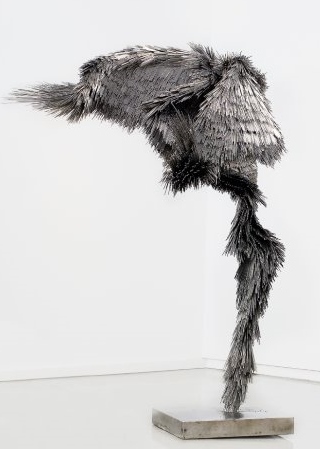
Featured Item

Murmurations of magic at Cape art fair
MOIRA SCHNEIDER
This talented 27-year-old multi-disciplinary artist was represented by the Matter Gallery in Toronto, Canada, at the fair which took place from 15 to 17 February.
Singer was carefully selected from around the world as one of the few SOLO new-media artists, in keeping with the world trend of integrating new media into traditional art fairs.
Singer has certainly trod the path less travelled in his artistic endeavours. “I have always been interested in experimentation in a variety of media,” says the artist, who works in the fields of sculpture, photography, and drawing. “I also paint secretly,” he admits.
“I’m always trying out things in new media and looking for a unique gesture and that allows me to avoid making derivative or generic work. I’m also aware that sometimes the work that I make references other extraordinary artists.”
Singer matriculated at Hilton College in KwaZulu-Natal, then graduated with a BA in Fine Arts (Honours) cum laude at the University of Cape Town’s Michaelis School of Fine Art in 2013. He is distinguished by a large-scale steel sculpture at the top of the W+A Building in the Maboneng precinct in Johannesburg.
Singer says that the work he presented at the fair represents new technology, futurism, and science fiction. Yet some of the techniques he used were traditional ones. “I’m just using them, innovating them, and bringing them into the space of new media,” he says.
His Murmuration series, for example, consists of bird-like sculptures made of thousands of tiny pieces of stainless-steel rods. “The murmuration phenomenon describes how a number of simple entities come together to form a complex behaviour as a collective,” he explains.
“If you look at the way a flock of birds fly, the way schools of fish swim, or even the way that people run in crowds – that’s murmuration.”
Singer believes the reason he was selected to exhibit at this fair was because, “I’m interested in serious contributions to the field of contemporary art, and I’ve been making very experimental work professionally for the past five years and working with a Toronto gallery for the past two years.
“They [the organisers of the fair] see my contributions to art and how I engage audiences, and I think they thought it would be a good show – work that I think people can relate to.”
Needless to say, he agrees that his work pushes the boundaries in its distinctiveness. “I think all good art is not necessarily derivative, it’s expanding a genre.
“In a sense, I work in conversation. The Murmuration series is in conversation with a work called the Nike of Samothrace (Winged Victory),” one of the most celebrated sculptures of antiquity on display at the Louvre. “The sentimental victory, positivity, and energy are echoed in a sculpture like that, and in a way, I’m just part of this very long conversation of creating.”
There are also references to Botticelli in his work. So, while he believes in innovation, he is not averse to adopting elements in a nod to the great artists of days gone by.
Singer describes his studio as being “something like a science lab. I’m experimenting with different materials and arranging them. So, everything from resin to bonded materials, different substrates, silicones, it’s a process of constant creation, experimentation, and exploration.”
An avid reader, Singer mentions that he is inspired by William Gibson’s book Neuromanca, which he describes as “almost a predecessor to The Matrix, a seminal text of science fiction”; cultural stories of creation; and biblical stories. “I think that there’s extraordinary wisdom in ancient texts, and it’s something that I draw on.”
He adds that a substantial part of his work feeds off Johannesburg’s “raw, dynamic energy”.
In 2012, Singer interned with William Kentridge for The Refusal of Time, a five-channel digital video installation. He describes this as “an extraordinary experience. I saw all the possibilities of what a studio is and what it could be”.
“There were a lot of people at the workshop – technical assistants, dressmakers, set designers, production managers, video editors, Harvard professors. For me, the creative energy and resonance amongst a whole group of people coming together, sharing their skills, working towards an articulation that was not necessarily economic, I think that’s the closest thing you can get to magic.
“That is my purpose – to make magic, and to usher magic into the world. I hope that when somebody sees my work, they have an emotional reaction and are able to connect. The reaction can be intellectual if they wish it to be, but [it can] also just [be] visceral.
“By exploring the impact that new media has had on traditional media, and vice versa, we hope that a full picture will emerge of the state and future of art practice on the African continent,” says Galleries and Special Projects Manager Khanya Mashabela.
“By progressing to new traditions, it is hoped that emerging practitioners and collectors will begin to think more analytically about the impact of the digital world on art.




